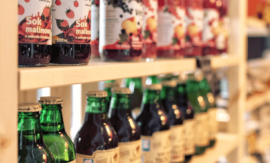Intended learning outcomes: Differentiate between various concepts for planning & control within the company. Using process charts for synchronization between use and manufacturing with inventory control processes. Elaborate a basic process analysis as well as manufacturing processes in the company-internal layout.
Course section 4.8: Subsections and their intended learning outcomes

4.8 Scenarios and Exercises
Intended learning outcomes: Differentiate between various concepts for planning & control within the company. Using process charts for synchronization between use and manufacturing with inventory control processes. Elaborate a basic process analysis as well as manufacturing processes in the company-internal layout.

4.8.1 Scenario: Concepts for Planning & Control within the Company
Intended learning outcomes: Identify different companies together with their products or product families where different concepts would be adequate for planning & control. Disclose the branch of industry the company is in and the production type(s) the company does implement for these products or product families.

4.8.2 Exercise: Synchronization between Use and Manufacturing with Inventory Control Processes
Intended learning outcomes: Explain decoupling of procurement or production from demand for two examples.

4.8.3 Exercise: Basic Process Analysis (BPA) and Manufacturing Processes in the Company-Internal Layout
Intended learning outcomes: Describe the basic process analysis (BPA) using the example of an aluminum frame. Present in detail the company-internal layout using this example process.
Course 4: Sections and their intended learning outcomes

Course 4 – Business Process Analysis and Concepts for Planning & Control
Intended learning outcomes: Explain important techniques in business process engineering. Describe characteristic features relevant to planning & control in supply chains. Disclose fundamental concepts in logistics and operations management.

4.1 Elements of Business Process Management
Intended learning outcomes: Produce an overview on terms in business process engineering. Describe order management and graphical representation of logistics processes.

4.2 Push Logistics and Pull Logistics in the Design of Business Processes
Intended learning outcomes: Differentiate between pull logistics and push logistics. Describe the temporal synchronization between use and manufacturing with inventory control processes.

4.3 Important Techniques of Analysis in Business Process Engineering
Intended learning outcomes: Explain the organization-oriented process chart as well as the detailed analysis and time study of processes. Disclose manufacturing and service processes in the company-internal and transcorporate layout.

4.4 Characteristic Features Relevant to Planning & Control in Supply Chains
Intended learning outcomes: Produce an overview on principle and validity of characteristics in planning & control. Explain six features in reference to customer, and item or product or product family, five features in reference to logistics and production resources, as well as seven features in reference to the production or procurement order. Describe important relationships between characteristic features of transcorporate logistics in supply chains.
4.5 Branches, Production Types, and Concepts for Planning & Control
Intended learning outcomes: Describe branches of industry in dependency upon two characteristic features, "volume versus variety". Explain in detail production types and concepts for planning & control. Disclose selecting an appropriate branch model, production type, and concept for planning & control.

4.6 Summary
.

4.7 Keywords
.

4.8 Scenarios and Exercises
Intended learning outcomes: Differentiate between various concepts for planning & control within the company. Using process charts for synchronization between use and manufacturing with inventory control processes. Elaborate a basic process analysis as well as manufacturing processes in the company-internal layout.
